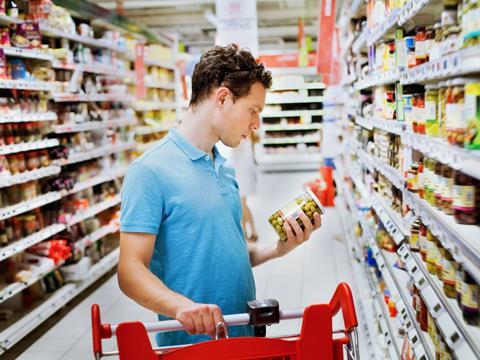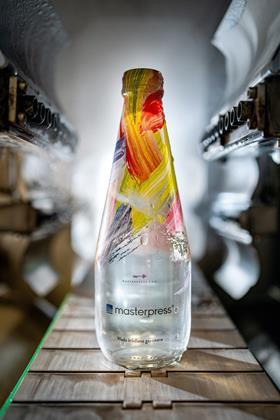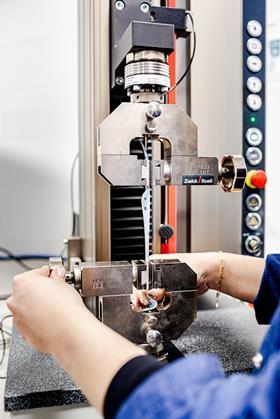
As Europe goes about introducing new packaging and packaging waste rules, where do label and printed decorative packaging manufacturers’ responsibilities lie? Gabriel Magdaleno, foreign sales director at Masterpress, explains how digital watermarking, choosing the optimal material for each label application, improving consumer awareness and participation in sustainability schemes, and more can help the EU reach its goals.
According to Eurostat’s 2022 “Packaging Waste Statistics”, in 2021, a staggering 84.3 million tons of waste was generated in the European Union – in other words, an average of 188.7 kg per person and an increase over the previous year of 22.5%. All stakeholders have recognized the urgency of this situation and the corresponding need for an integrated, collaborative approach along all links in the value chain, especially in the context of the EU’s ambitious 2030 goals for packaging and packaging waste.
Faced with similar increases in packaging waste for the foreseeable future, the printed decorative packaging industry finds itself in a pivotal role in addressing this challenge.

Gabriel Magdaleno, foreign sales director at Masterpress
Revision of Directive 94/62/EC on Packaging and Packaging Waste (REFIT)
The European Parliament, during its plenary session, endorsed its stance on the proposed regulation and on December 18, 2023, the European Council adopted its position on the proposal. This general approach will set the stage for negotiations between the European Council and Parliament regarding the final form of the Packaging and Packaging Waste legislation.
Both institutions must formally approve the final text, assumed to fall within the Belgian Presidency during the first half of 2024. The final text will likely include:
Waste Reduction Targets:
- 5% reduction by 2030
- 10% reduction by 2035
- 15% reduction by 2040
Exemptions for Member States:
- Allowances for exemptions under specific circumstances
- Potential exemptions for organic fruit and vegetables
Collection Targets for Single-Use Plastics:
- EU members to collect 90% of single-use plastic bottles and “metal” beverage containers annually by 2029
Deposit Return Systems:
- Mandatory implementation for the collection of single-use plastic bottles and metal beverage containers
Chemicals in Packaging:
- Measures to address chemicals hindering reuse or recycling
- Commission to collaborate with the European Chemicals Agency, aiming for a report by 2026
Reuse and Refill Targets:
- Varied rules for different product categories
- Exemptions for cardboard
- Excluding wine from the regulations

Industry’s opportunity to lead with innovative technologies that reduce environmental impact
The packaging and printing industry is ready and able to make a significant contribution to reduce the environmental impact of packaging and work with and across industry. By leveraging advanced technologies and strategic approaches, the industry can effectively respond to the growing demands for environmental responsibility and align with the goals of the European Union’s Packaging and Packaging Waste Directive (PPWD).
For example, some of the actions the packaging and printing industry can take to address this challenge:
- The integration of technologies like digital watermarking and switching from UV cured inks to LED inks signifies a leap towards more environmentally responsible practices. Digital watermarking, for instance, streamlines the recycling process by improving the sorting of materials, thereby aligning with the objectives of the EU Directive that emphasizes recycling and waste reduction.
The transition to LED inks reflects an industry-wide commitment to more sustainable printing processes by reducing energy consumption, emissions of hazardous materials, waste generation, and air pollution, resonating with the Directive’s push for sustainable practices. - Material choices in packaging are becoming increasingly crucial. The industry’s exploration of paper versus plastic, and other materials like glass, wood, metal, and bioplastics, is a testament to the search for sustainable and recyclable solutions.
This exploration is not just about choosing one material over another; it’s about understanding the lifecycle of each material and how they can complement each other in a circular economy. This approach aligns with the Directive’s focus on reducing waste and enhancing recyclability. - Consumer engagement through informative and engaging packaging design is another key area. The industry is moving towards designs that not only communicate recycling information clearly but also encourage reuse.
This aligns with the aim to involve consumers more actively in waste reduction efforts. The shift in labelling strategies to promote reuse over brand dominance reflects a deeper understanding of the role consumers play in the product lifecycle.
The future of sustainable packaging lies in embracing a diverse range of materials and technologies, each playing a role in reducing environmental impact. As the industry moves forward, it will be essential to balance innovation with practicality, ensuring that new solutions are not only environmentally friendly but also feasible and effective in real-world applications.
It involves technological innovation, strategic material choices, consumer engagement, and collaborative efforts across the industry. These efforts are not only about compliance but about leading the charge in ecological responsibility and setting a sustainable course for the future of packaging.

Impact of Labels and Films
In the dynamic landscape of the European Fast-Moving Consumer Goods (FMCG) packaging sector, producers are increasingly focused on high-quality labels and innovative printed decorative packaging solutions. These advancements are not just about aesthetics; they encompass designs, colours, and functionality that ensure safety, enhance desirability, and offer robust and unique brand representation.
Labels and films, though smaller in size compared to the overall packaging, play a significant role in the packaging waste stream. They are integral to product branding and information dissemination but pose unique recycling challenges.
Labels, for instance, can be made from a variety of materials, including paper, plastic, and foil, often with adhesive backings that contaminate recycling streams. Films, used for wrapping and sealing products, vary widely in material composition, adding another layer of complexity to the recycling process.
As we look towards 2030, it’s imperative to acknowledge the honest role and potential of the labelling, films, and packaging industry in spearheading more environmentally friendly innovations. A key aspect of this evolution involves the reduction of packaging weight (lightweight) and the optimization of packaging for specific products, such as the use of thinner films.
Downgauging to thinner materials not only reduces the quantity of material but also minimizes waste. At the same time, we should also look to using a greater proportion of recycled materials, reducing the use of virgin plastic.
For example, at Masterpress we are currently running feasibility tests for plastic sleeve labels with 50% recycled content. Additionally, the shift towards recyclable materials has been gaining momentum, with companies exploring new substrates and mono-material packaging solutions that can be easily processed in recycling facilities.
Call out box: The TINE 300g Dairy Cup Sleeve
Made for Berry Superfos Lidköping and produced by Masterpress, the Dairy Cup Sleeve encompasses the company’s commitment to sustainable packaging and reflects “designed-for-recycling” standards set by RecyClass. The packaging introduces a low-density polyolefin shrink sleeve material creating a “mono-material-like” solution that facilitates proper identification and recycling of the cups in the correct polymer stream.
Additionally, this sleeve uses thinner, 45μ polyolefin, effectively reducing the amount of material for a lower carbon footprint and more environmentally friendly packaging solutions. The design helps to ensure the cups are correctly recycled, lessening environmental impact and pushing the packaging industry towards more “good-for-recycling” solutions. This design demonstrates how thoughtful material selection and design can result in a fully recyclable product without compromising functionality or aesthetic appeal.

Masterpress’ TINE 300g Dairy Cup Sleeve produced for TINE SA won in the Environmental Winner category.
The role of collaboration and the responsibility of all involved parties
However, implementing new technologies alone is not enough to meet the ambitious 2030 goals. Coordination along the value chain is essential for successfully implementing technologies that align with the three Rs (Reduce, Reuse, Recycle) challenge set by the PPWD by 2030.
This holistic approach demands an integration of environmental considerations, brand marketing strategies, and consumer guidance focused on a more sustainable future. Designing products and packaging that not only appeal to conscientious consumers but also enhance brand value is crucial.
Furthermore, these designs must be user-friendly, ensuring ease of use in terms of the three Rs. The ultimate goal is to meet consumer needs by offering products that are not only functional but also environmentally responsible, thereby fulfilling the PPWD’s objectives and contributing to a more sustainable future.

Meeting the ambitious goals outlined by the PPWD will therefore require a re-evaluation of the typical “Extended Producer Responsibility” (EPR) doctrine. The EPR has traditionally placed the onus on producers to manage the environmental impacts of their products throughout their life cycle.
However, to effectively address the challenges of the three Rs, a more inclusive approach is needed. This calls for the value chain, including regulators and consumers to equally share the responsibility and costs.
Such an approach recognizes that every participant in the product lifecycle – from packaging industries and labelling companies to transportation, retail, consumers, and recycling sectors – plays a vital role in the environmental footprint of products. Each and every link in the value chain should contribute to the solutions and innovations required.
Europe, while leading in regulatory changes like the PPWD, is not alone in this journey. Globally, various regions are implementing similar regulatory changes, emphasizing the importance of sustainable practices across the entire value chain.
Europe, with its progressive policies, can set a precedent and lead the world in achieving a more sustainable and environmentally responsible industry standard. By citing global examples and learning from them, Europe can refine its strategies, encouraging a more collaborative and holistic approach to environmental responsibility.
Conclusions
Achieving the ambitious 2030 goals set by the PPWD hinges on the development of flexible solutions that can adapt to diverse regulatory, technological, and cultural needs, both now and in the future. A more nuanced strategy is required, one that considers the unique regulatory landscapes, ongoing technological developments, and cultural practices of different regions.
To successfully navigate these complexities, shared responsibility across the entire value chain is imperative. This means moving beyond the traditional EPR doctrine and fostering collaboration among all stakeholders, including manufacturers, retailers, consumers, and recycling sectors while simultaneously ensuring the engagement of regulators and consumers.
The path to meeting the PPWD’s 2030 objectives is multifaceted, requiring a harmonious blend of shared responsibility, collaborative effort, and relentless innovation. By embracing these principles and understanding that new innovations will continue to advance recycling, it is possible to create a sustainable future that accommodates a variety of needs and paves the way for global environmental stewardship.
If you liked this story, you might also enjoy:
The Brief: How viable is biorecycling for plastics?
Report: How the top brands are progressing on packaging sustainability
The Brief: Using ocean-bound plastic in packaging – how, why and should we?











No comments yet